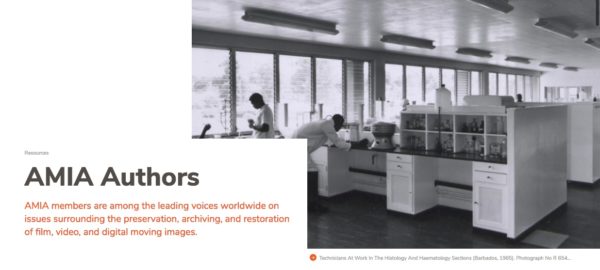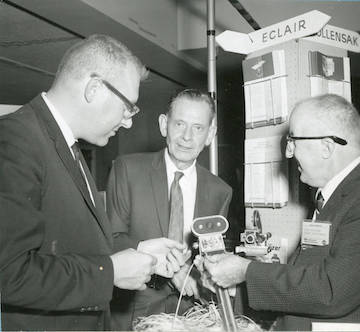Click here to print
AMIA Authors: Writing about Moving Image Archiving
posted March 4, 2019
If you wonder how to film on 3mm cameras, or safeguard born-digital media content, or navigate the choppy waters of new-media creation and preservation, you will find leads on AMIA Authors, a recently launched website of items about moving-image archiving.
 It presents many articles of interest to both specialists and general readers, written by members of AMIA – the international Association of Moving Image Archivists.
It presents many articles of interest to both specialists and general readers, written by members of AMIA – the international Association of Moving Image Archivists.
Their publications on the preservation, archiving, and restoration of film, video, and digital moving images appear in such publications as AMIA’s own journal, The Moving Image, and other specialist publications; or, they may appear in the popular press.
In either case, it’s material that general readers fascinated by film archiving can easily miss. While most of the publications are traditional print essays and articles, some are video essays and podcasts, or recordings of appearances on television, radio, and online programs. In whatever medium, they provide perspectives on film making, distribution, copyright, collecting, curating, digitization, history, and advocacy.
The site has links to books, articles, video essays, podcasts, and other publications relating to moving image archiving, preservation, and restoration. It also has links to sites where various moving-image-archiving publications can be purchased or accessed via library subscriptions.
Browsing the listings, you’ll come across some fascinating reading and viewing. You’ll find, for example, a fascinating history of the minuscule 3mm film format.

Eric M. Berndt (center) with his Cine 3 System camera and film in 1960. Edwards Air Force Base deployed the sub-miniaturized motion-picture camera, which used 3mm film, as a cockpit-photography application. Chapman University Jonathan Silent Film Collection.
In journal publications from 2018, three researchers from the Netherlands Institute for Sound and Vision, Maarten Brinkerink, Gertjan Kuiper, and Jesse de Vos, published a statement — a manifesto, even — about how public broadcasters and the Wikimedia movement can emulate the way that the Dutch public broadcaster, VPRO, has set the standard for open publication of content. The authors provide recommendations on how to proceed through various stages of open publication, from pre-production to “afterlife.”
Another publication from the Netherlands Institute for Sound and Vision is overtly a manifesto: the authors of FREEZE! A manifesto for safeguarding and preserving born-digital heritage call on archivists to find ways to preserve born-digital materials, as a matter of some urgency. They discuss such media as websites, video and online games, and interactive documentaries. They write: “Ensuring that our digital lives and digital creativity are not lost to future generations requires a joint effort by the principal players: creators, heritage professionals, and policy makers. This manifesto lays out the actions they need to take today to safeguard born-digital heritage.”
In his white paper, “Towards a New Audiovisual Think Tank for Audiovisual Archivists and Cultural Heritage Professionals,” Peter B. Kaufman, a documentary-film producer and president of Intelligent Television media productions, recommends 10 ways for audiovisual archives to set priorities in an often overwhelming era of change. He suggests how to create new partnerships and revenue models, experiment with technology, support free and liberal licenses, and work more closely with creators.
AMIA Authors will be updated quarterly.
Printed from Moving Image Archive News: https://www.movingimagearchivenews.org
URL to article: https://www.movingimagearchivenews.org/amia-authors-writing-about-moving-image-archiving/
Click here to print